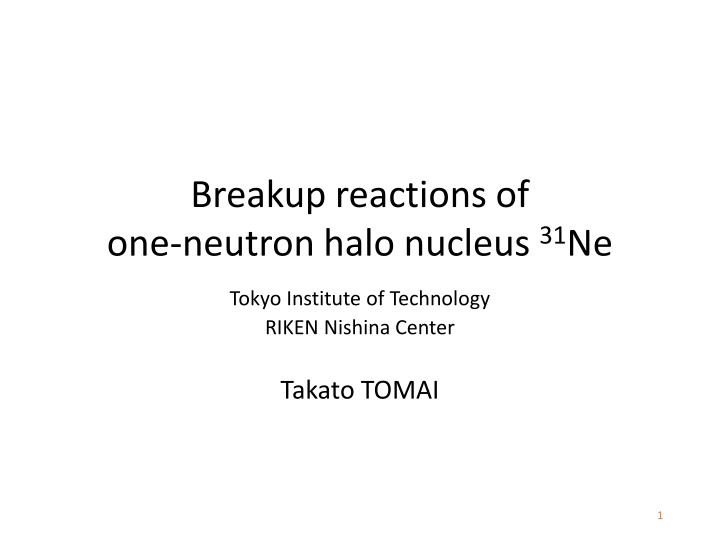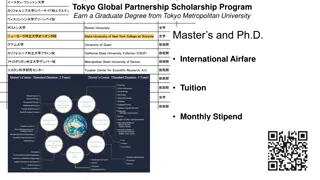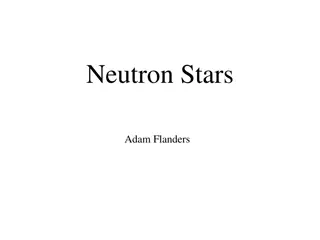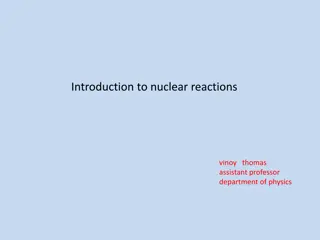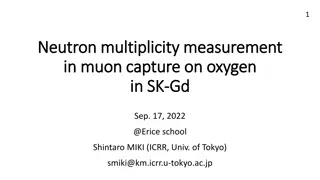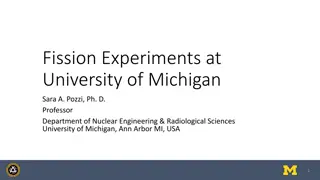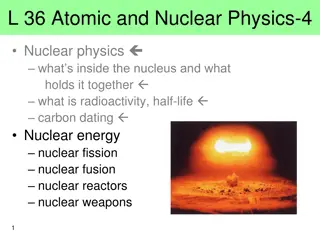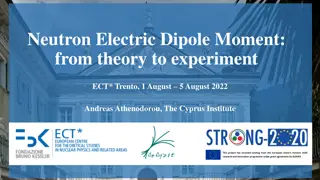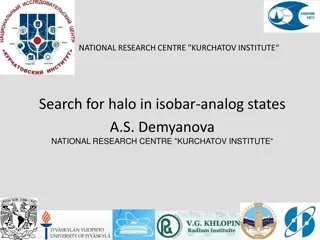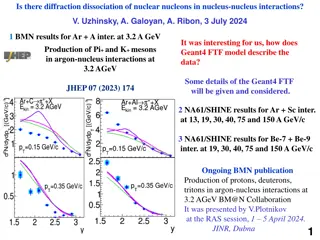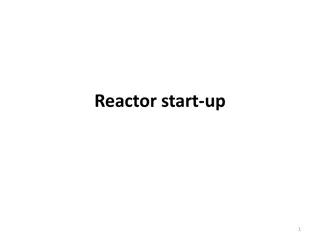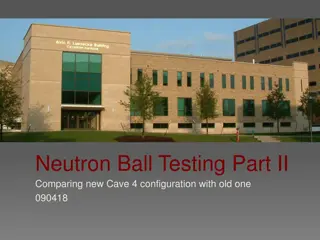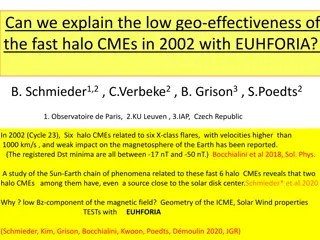Breakup Reactions of 31Ne Neutron Halo Nucleus at Tokyo Institute of Technology and RIKEN Nishina Center
Collaborators from various institutes worked on revealing the properties of the 31Ne nucleus, including its neutron island of inversion, large interaction cross-section, and low separation energy. The exclusive measurement of the Coulomb breakup reaction provided insights into the nucleus's halo structure. Experimental setup at BigRIPS at RIBF utilized a superconducting ring cyclotron with a primary beam of 48Ca.
Download Presentation

Please find below an Image/Link to download the presentation.
The content on the website is provided AS IS for your information and personal use only. It may not be sold, licensed, or shared on other websites without obtaining consent from the author.If you encounter any issues during the download, it is possible that the publisher has removed the file from their server.
You are allowed to download the files provided on this website for personal or commercial use, subject to the condition that they are used lawfully. All files are the property of their respective owners.
The content on the website is provided AS IS for your information and personal use only. It may not be sold, licensed, or shared on other websites without obtaining consent from the author.
E N D
Presentation Transcript
Breakup reactions of one-neutron halo nucleus 31Ne Tokyo Institute of Technology RIKEN Nishina Center Takato TOMAI 1
Collaborators Collaborators T. Tomai,A,C N. Kobayashi,B T. Nakamura,A Y. Togano,Q Y. Kondo,A S. Takeuchi,E A. T. Saito,A T. Ozaki,A A. Hirayama,A M. Yasuda,A H. Yamada,A T. Kobayashi,D S. Koyama,E S. J. Kim,F J. W. Hwang,F H. Otsu,C Y. Shimizu,C N. A. Orr,G J. D. Gibelin,G T. Aumann,H H. Sato,C P. C. Doornenbal,C H. Baba,C T. Isobe,C N. L. Achouri,G M. Marques,G F. L. Delaunay,G Q. Deshayes,G A. Revel,I O. Sorlin,I V. Panin,C I. Ga pari ,J H. T. T rnqvist,H S. Y. Park,K I. K. Hahn,K Y. Kubota,C M. Sasano,C L. Stuhl,E D. H. Kim,K M. Matsumoto,A M. Parlog,G D. M. Rossi,H L. Atar,H S. Lindberg,L J. Kahlbow,H S. Paschalis,M S. Sakaguchi,N R. Reifarth,O L. Mullay,C F. Browne,P M. L. Cortes Sua,C S. D. Chen,C J. SteinhauserA Institute TokyoTechA, Osaka U. RCNPB, RIKEN Nishina centerC, Tohoku U.D, U. Tokyo CNSE, Seoul N. U.F, LPC-ENSICAENG, GSIH, GANILI, IRBJ, Ewha W. U.K, Chalmers U. T.L, U. YorkM, Kyushu U.N, U. FrankfurtO, U. BrightonP, U. RikkyoQ 2
31Ne? Island of inversion 2p3/2 Z 31Ne neutron What are revealed? 7/2- N N=20+1 1n p-wave dominant halo (J =3/2-) Large interaction cross section Low separation energy: Sn=0.15+0.16-0.10 MeV Small spectroscopic factor: C2S(0+;2p3/2)=0.32+0.21-0.17 Separation Energy Spectroscopic factor From: Indirect estimation [1] T. Nakamura, N. Kobayashi et al. Phys. Rev. Lett. 103, 262501(2009) [2] M. Takechi et al. Phys. Lett. B 707 (2012) 357 [3] T. Nakamura, N. Kobayashi et al. Phys. Rev. Lett. 112, 142501 (2014) 3
Previous work: Inclusive measurement 31Ne + Pb 30Ne + X Pb C2S Not measured High-Z C Sn (MeV) Estimated from integrated cross sections Compared with some theoretical model (SM etc.) Need differential cross sections [1] T. Nakamura, N. Kobayashi et al. Phys. Rev. Lett. 103, 262501(2009) [2] M. Takechi et al. Phys. Lett. B 707 (2012) 357 [3] T. Nakamura, N. Kobayashi et al. Phys. Rev. Lett. 112, 142501 (2014) 4
Exclusive measurement: Coulomb breakup reaction 31Ne + Pb 30Ne + n p30Ne E30Ne Invariant mass Erel , Ex pn En E1 strength GDR Halo: Soft E1 ~1 MeV Equivalent photon method Photon number E1 strength Photon num. (log) d /dEx Enhance Soft E1 Ex (MeV) [4] C. A. Bertulani, G. Baur, Phys. Rep. 163, 299(1988). 5
Coulomb breakup reaction as a probe of halo structure Example: Coulomb breakup of 19C Different shape by Separation energy neutron orbital spectroscopic factor Sn, l [5] T. Nakamura et al. Phys. Rev. Lett. 83, 1112 (1999) 6
Experimental setup: BigRIPS @ RIBF Superconducting Ring Cyclotron Plastic 0.5mm 2 Primary beam 48Ca 345 MeV/u Plastic 3mm Ionization Chamber F5 E Primary target Be 15mm F3 F7 F13 Secondary beam 31Ne 240 MeV/u B TOF SAMURAI Particle Identification 7
Experimental setup: BigRIPS @ RIBF 33Na Superconducting Ring Superconducting Ring Cyclotron Cyclotron ~50cps 31Ne Plastic 0.5mm 2 Primary beam 48Ca 345 MeV/u Plastic 3mm Plastic 3mm Ionization Chamber F5 F5 E 29F Primary target Be 15mm F3 F3 F7 F7 F13 Secondary beam 31Ne 240 MeV/u B B TOF SAMURAI Intensity: 10 times higher than previous work 8
Experimental setup: SAMURAI @ RIBF Plastic array Neutron detectors CsI(Na) array -ray detector CATANA Plastic 0.5mm 2 NeuLAND NEBULA SAMURAI Dipole Magnet @ 2.9 T n (TOF) 31Ne ~240 MeV/u C target: 2.15 g/cm2 Pb target: 2.76 g/cm2 MWDC (B ) 30Ne Plastic array HODF24 (TOF, E) Charged particle detectors 9
Result 1/4: Inclusive cross sections PID of reacted particles (31Ne gated in upstream) 30Ne C target (mb) Pb target (mb) 31Ne 30Ne 89(3) 674(28) 31Ne (beam) Previous work 90(7) 720(61) Consistent with previous work [3] T. Nakamura, N. Kobayashi et al. Phys. Rev. Lett. 112, 142501 (2014) 10
Result 2/4: Exclusive diff. cross section of Coulomb breakup reaction Pb(31Ne,30Ne+n) Coulomb breakup spectrum Nuclear breakup component [6] Lead target Carbon target 11 Integral 0 5 MeV: 479(18) mb For Lead target Integral 0 5 MeV: 392(18) mb For Coulomb breakup [6] K. Yoshida et al., Prog. Theo. Exp. Phys. 2014, 5, 053D03
Result 3/4: Excited state component of Coulomb breakup reaction How is excited state component of 30Ne(2+) ? 31Ne + Pb 30Ne + + n 2+ Exclusive (mb) (require n) Integral Erel=0-5MeV 30Ne+n 31Ne Lead target 31Ne 30Ne(total) 479(18) 30Ne(2+) 792 keV 31Ne 30Ne(2+) 136(24) 31Ne 30Ne(0+) 343(30) Ratio( 0+ : 2+) 72(6)% : 28(5)% 12
Result 4/4: 1n separation Energy and spectroscopic factor Fitted with 2 curves (30Ne(0+) 2p3/2 + 30Ne(2+) 2p3/2) 72% 28% C2S (30Ne(0+);3/2-) C2S (30Ne(2+);3/2-) Sn (MeV) Total This work 0.30(1)+sys. 0.32(1)+sys. 0.41(2)+sys. 0.15+0.16-0.10 0.32+0.21-0.17 Prev. work --- 30Ne(0+) 2p3/2 SDPF-M 0.21 0.34 30Ne(2+) 2p3/2 [3]T. Nakamura, N. Kobayashi et al. Phys. Rev. Lett. 112, 142501 (2014) Consistent with previous work double component halo 2+ 0+ 13
Summary We carried out the nuclear/Coulomb breakup reaction of 31Ne using SAMURAI at RIBF Determined Coulomb breakup reaction differential cross section: Preliminary result of 1n separation energy and spectroscopic factor C2S (30Ne(0+);3/2-) C2S (30Ne(2+);3/2-) Sn (MeV) This work 0.30(1)+sys. 0.32(1)+sys. 0.41(2)+sys. 0.15+0.16-0.10 0.32+0.21-0.17 Prev. work --- Future: Determine systematic errors 14
Purpose 1: Configuration of ground state using Coulomb breakup reaction 31Ne + Pb 30Ne + n Spectroscopic Factor Virtual Photon Num. Distance (Core-n) Depending on 1n separation energy Sn and angular momentum l Determination of 31Ne halo structure 15
Purpose 2: Observation of deformation using nuclear breakup reaction 31Ne + C 31Ne* 30Ne + n Excited energy can be calculated using this: Observation of unbound excited state Comparison with rotational band 16
Excited state component of Coulomb breakup reaction How is excited state component of 30Ne(2+) ? 31Ne + Pb 30Ne + + n Inclusive (mb) (not require n) Exclusive (mb) (require n) Integral Erel=0-5MeV Lead target 30Ne(2+) 792 keV 31Ne 30Ne(total) 674(28) 479(18) 31Ne 30Ne(2+) 234(30) 136(24) 31Ne 30Ne(0+) 440(41) 343(30) Ratio(2+/0+) 53% 40% 18
1n separation Energy and spectroscopic factor (I) Fitted with theoretical curve (assuming =0): C2S (30Ne(0+);3/2-) Sn (MeV) This work 0.306(26) 0.39(3) 0.15+0.16-0.10 0.32+0.21-0.17 Previous work T. Nakamura, N. Kobayashi et al. Phys. Rev. Lett. 112, 142501 (2014) Consistent with previous work Fitting was NOT perfect 19
